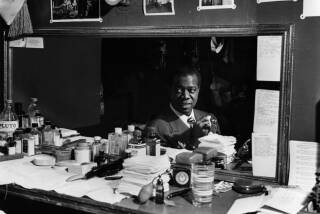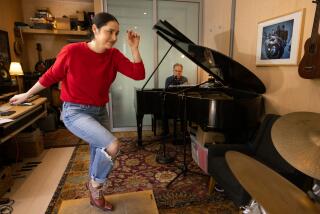Pleasing Tribute to Gillespie Hits a Few Clunkers
- Share via
Dizzy Gillespie is a tough act to follow. Correctly known as one of the founding fathers of bebop, he is credited perhaps a bit less than he should be as a first-rate composer, arranger and band leader. Add to that his engaging skills as an entertainer, scat singer and jokester, and a complete picture of Gillespie as one of the consummate 20th century artists emerges.
So the decision by the Orange County Performing Arts Center’s Jazz Club to celebrate his life Friday and Saturday nights in a program titled “Dizzy: The Man and the Music” was a good one. But the question was how to do so in a fashion that fully delineated the many facets of his skills.
The proposed answer was a program touching upon some of Gillespie’s best-known compositions, performed by a six-piece ensemble featuring trumpeter Roy Hargrove, tenor saxophonist Don Braden, trombonist Robin Eubanks, pianist Mulgrew Miller, bassist Bob Cranshaw and drummer Ignacio Berroa.
In principle, it was a pretty good solution. Hargrove is a trumpeter with the instrumental range and improvisational imagination to deal effectively with the Gillespie musical legacy. And the balance of the group, although stylistically oriented toward post-bebop styles, were--like most musicians who emerged in the ‘80s and ‘90s--firmly grounded in the bebop tradition.
In that sense, the sextet mounted an appealing Gillespie tribute. Hargrove slanted his improvisations toward a somewhat brighter bop coloration than is generally his style, and his high-note passages on tunes such as “Groovin’ High” resonated with Gillespie memories. The balance of the program, which included “Blue ‘N Boogie,” “Tin Tin Deo” and “Con Alma” among other bop classics, was executed effectively, emphasizing long, improvisational passages. Beyond Hargrove’s work, the soloing was generally first-rate, especially from Braden and Eubanks.
But the rhythm section--perhaps in part because of the last-minute addition of Cranshaw in place of the scheduled John Lee--never really jelled. Although all the pieces were in the right places, the electric rhythmic surge demanded by the bop style was rarely there.
Equally apparent, and despite all good intentions, the program captured only a limited view of Gillespie’s far-reaching creativity. Pleasant enough as an evening of jazz, it will have been most productive if it directs some of the enthusiastic audience back to the source, to the many recordings of Gillespie, himself, in action.
More to Read
The biggest entertainment stories
Get our big stories about Hollywood, film, television, music, arts, culture and more right in your inbox as soon as they publish.
You may occasionally receive promotional content from the Los Angeles Times.










